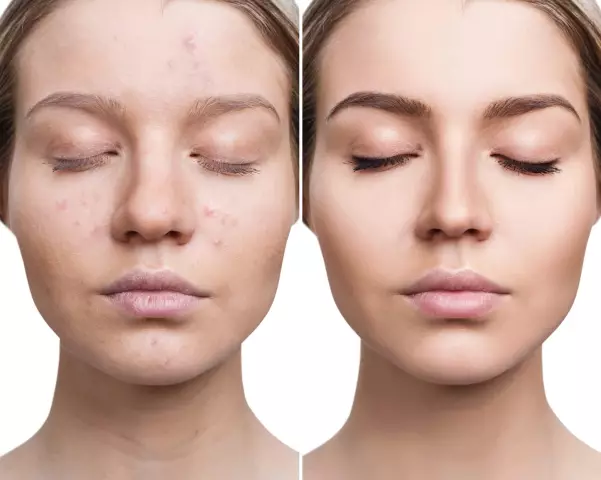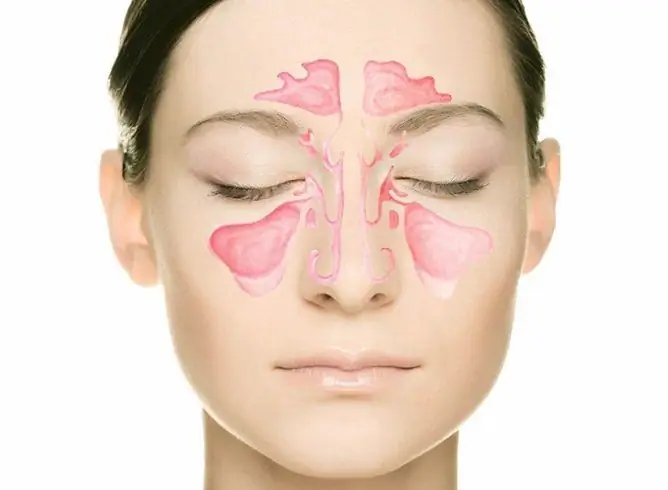- Author Rachel Wainwright [email protected].
- Public 2023-12-15 07:39.
- Last modified 2025-11-02 20:14.
Odontogenic sinusitis: treatment, symptoms, which doctor to go to
The content of the article:
- Forms of the disease
- The reasons for the development of the disease
- Symptoms of odontogenic sinusitis
- Complications
- Diagnostics
- Treatment and prevention
- Video
Odontogenic sinusitis is one of the types of sinusitis, the cause of which is the defeat of the teeth of the upper jaw (most often - premolars or molars). Its occurrence is due to the peculiarities of the anatomical arrangement of the teeth and the maxillary sinus, which is the largest of the paranasal cavities.
Patients diagnosed with odontogenic sinusitis can be admitted to both dental and otorhinolaryngological hospitals. The prevalence averages 15-25% and can reach 50% in the population.

The development of odontogenic sinusitis is caused by damage to the teeth of the upper jaw
Forms of the disease
Most often, odontogenic inflammation of the mucous membrane of the maxillary sinus is unilateral.
According to the severity of the disease, the following forms are distinguished:
- easy;
- medium-heavy;
- heavy.
Depending on the duration of the disease, sinusitis is distinguished:
- acute (up to 1 month);
- recurrent (2-4 episodes of inflammation per year);
- chronic (from 2-3 months).
Depending on the nature of odontogenic lesions, the following forms are distinguished:
- closed: against the background of chronic periodontitis; associated with suppuration of odontogenic cysts ingrown into the sinus;
- open: perforated sinusitis (for example, due to removal of the I - II molar); developed as a complication of chronic osteomyelitis of the alveolar ridge or jaw body.
According to the form of the disease, sinusitis is distinguished:
- exudative or catarrhal, which is accompanied by the release of an inflammatory fluid, depending on this, a serous, mucous or purulent form is released;
- productive, which is characterized by the growth of the mucous membrane of the sinus. Depending on the nature of growth, it is divided into: parietal-hyperplastic (thickening of the mucous membrane without purulent discharge); polypous (the formation of polyps in the nose and sinuses).
ICD-10 code: J01.0 and J32.0 (acute and chronic maxillary sinusitis).
The reasons for the development of the disease
Odontogenic inflammation most often occurs as a result of the spread of a focus of chronic infection in the premolars or molars of the upper jaw. In this case, the pathological process can be represented by the following diseases:
- periodontitis;
- periostitis;
- osteomyelitis;
- suppurating cysts;
- abscessing form of periodontitis.

The cause of sinusitis can be diseases of the teeth of the upper jaw, including periodontitis and periostitis.
Also, in the occurrence of odontogenic inflammation of the maxillary sinus, endodontic therapy plays an important role, as a result of which perforation of the apical foramen is possible during dental treatment of premolars and molars, when filling material, elements of an intraosseous implant enter the sinus cavity. Much less often, the cause of the disease is traumatic injuries of the teeth or upper jaw, which are accompanied by perforation of the sinus wall.
The disease can progress rapidly in the presence of concomitant chronic pathologies, a general decrease in immunity.
Symptoms of odontogenic sinusitis
Acute odontogenic sinusitis is characterized by:
- acute throbbing headache or toothache;
- pain in the upper jaw and swollen gums;
- increased pain when pressing on the bridge of the nose, orbit and cheeks on the affected side;
- signs of general intoxication: weakness, dizziness, chills;
- nasal congestion and profuse mucous or mucopurulent discharge;
- a feeling of fullness in the upper jaw on the affected side;
- pain when chewing;
- an increase in body temperature up to 38.5-39.5 ° C;
- inability to recognize smells and tastes;
- increased lacrimation, photophobia.
The chronic course of the disease is characterized by a slow, undulating course with exacerbations against the background of hypothermia and ARVI (acute respiratory viral infections). The most common symptoms are:
- unilateral headache and / or toothache;
- a feeling of heaviness and pressure in the nose, cheeks on the side of the sinus lesion;
- pain in the upper jaw with irradiation into the eye socket, temple;
- Difficulty nasal breathing;
- discharge from the nose: profuse or scanty, serous or purulent (depending on the process);
- unpleasant smell from the nose and mouth.
Complications
The consequences of odontogenic sinusitis can be:
- spread of the process to the frontal sinuses and ethmoid cells;
- otitis;
- adenoiditis, tonsillitis;
- phlegmon of cellulose of the orbit;
- neuritis of the optic or trigeminal nerve;
- osteomyelitis of the upper jaw;
- spread of infection in the bronchopulmonary system with the development of bronchitis, pneumonia;
- meningitis;
- brain abscesses;
- cavernous sinus thrombosis;
- sepsis.
Diagnostics
Diagnosis of odontogenic maxillary sinusitis is difficult, since some dental pathologies are asymptomatic and in many cases may not be regarded as the cause of sinusitis. Underestimation of the connection between inflammation of the maxillary sinus and diseases, anomalies in the development of teeth can lead to diagnostic errors and a recurrent course of the disease.

The disease is characterized by the accumulation of purulent discharge in the maxillary sinus.
When deciding which doctor to go to with sinusitis, the patient must take into account that to determine the cause of the disease in the presence of characteristic symptoms, it is necessary to consult not only an otorhinolaryngologist. For the diagnosis and treatment of dentoalveolar pathology, a dental examination is required. The diagnosis is established based on the data obtained:
- disease history;
- objective examination, which includes rhinoscopy, endoscopic examination of the oral cavity and nose;
- clinical blood test, bacteriological culture of the sinus discharge;
- X-ray examination (plain radiography, orthopantomography);
- computed tomography of the paranasal sinuses.
With anterior rhinoscopy, there is hyperemia and edema of the mucous membrane of the corresponding half of the nasal cavity, edema of the middle or lower nasal concha. Mucus or pus is usually secreted from under the middle turbinate.
Puncture of the maxillary sinus is performed for both diagnostic and therapeutic purposes. In the punctate of the maxillary cavity, aerobic and anaerobic flora is found, which is most often represented by staphylococci, streptococci, pneumococci, Haemophilus influenzae, Pseudomonas aeruginosa, fusobacteria, bacteria of the genus Veilonella and prevotella.

X-ray examination is prescribed to diagnose the disease.
X-ray examination is carried out in several projections. In the photo (X-ray), a homogeneous darkening of the sinus, thickening of the mucous membrane due to edema, is determined. When taken in an upright position, the pus looks like a liquid level.
Treatment and prevention
Treatment of odontogenic sinusitis should be comprehensive. It includes:
- broad-spectrum antibiotics;
- sanitation by a dentist of an odontogenic focus of infection;
- puncture (washing) of the maxillary sinus cavity with the introduction of saline. An alternative would be to flush the sinuses with a vacuum aspirator;
- vasoconstrictor drugs (decongestants).
Typically, the affected tooth is removed. After rinsing the tooth canal with an antiseptic solution, the doctor, if necessary, can install drainage to better drain the cavity contents.
The optimal choice of antibacterial agents reduces the duration of therapy. Protected penicillins (Amoxiclav) and fluoroquinolones (Moxifloxacin, Ciprofloxacin) are preferred.
Attention! Photo of shocking content.
Click on the link to view.
Conservative treatment is effective in the exudative form of the disease. Often, the inflammatory process that has developed as a result of prolonged periapical inflammation of the teeth of the upper jaw takes on a primarily chronic nature, requiring surgical intervention. The volume of the operation depends on the endoscopic picture, the state of the mucous membrane.
Treatment of odontogenic sinusitis with folk remedies can complement the main therapy. It includes:
- rinsing the nose with a solution of table or sea salt;
- inhalation with propolis;
- using rosehip or sea buckthorn oil.
Prevention consists in carrying out the following measures:
- timely treatment of carious teeth;
- sanitation of the oral cavity;
- increasing and strengthening immunity.
Video
We offer for viewing a video on the topic of the article.

Alina Ervasova Obstetrician-gynecologist, consultant About the author
Education: First Moscow State Medical University. THEM. Sechenov.
Work experience: 4 years of work in private practice.
Found a mistake in the text? Select it and press Ctrl + Enter.






